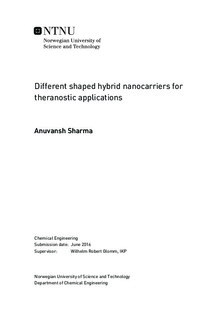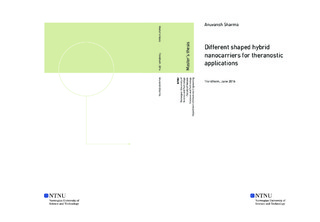| dc.description.abstract | Nanomaterials have gained a lot of attention in the past few decades as potential candidates for biomedical applications. They are being used as smart drug delivery vehicles among other applications such as wound dressing, tissue engineering, imaging, etc. Both polymeric and inorganic nanoparticles (NPs) are used, out of these materials, hydrogels and gold nanoparticles (AuNPs), have especially caught the global eye in medical field. Hydrogel s affinity towards water make them flexible and soft resembling the living cell tissue, thus rendering them apt for biomedical uses. Other properties like biocompatibility and biodegradability also add to their potential uses. Stimuli responsive hydrogels have provided a possible gateway for a triggered release of loaded material like drug, to the desired location thus, reducing toxicity and undesired side effects. AuNPs possess remarkable imaging and photothermal properties which are being currently exploited in medical research and applications. Hybrid NPs, formed by combining inorganic and polymeric NPs, have gained the attention of researchers around the globe aiming at combining the properties of different nano-systems into one single moiety. Thus, by combining the stimuli-responsive (temperature and pH) properties of hydrogels with the optical properties of AuNPs, a gateway to synthesis of smart NPs can be explored.
In this thesis, five different shapes of AuNPs namely, nanorods (AuNR), tetrahexahedral (AuHex), bipyramids (AuBP), nanomakura (AuNM) and spheres (AuNS), have been synthesized. The anisotropic NPs have been synthesized using a one-pot silver assisted seed-mediated synthesis protocol developed at Ugelstad laboratory, while the AuNS have been synthesized using a modified Turkevich method. The NPs have been characterized using Dynamic Light Scattering (DLS), zeta potential measurements, UV-Visible spectrophotometry (UV-Vis) and Scanning Transmission Electron Microscopy (S(T)EM).
A control study was performed involving three different nanocarrier systems to estimate the effect of incorporation method (incorporation of Fe@Au NPs in hydrogels) on loading and release of Cyt C, a model protein drug. The swelling-collapse properties of hydrogel, in situ grown hydrogels atop Fe@Au NPs (Fe@Au_insitu) and hydrogel coated Fe@Au NPs (Fe@Au_coated) were mapped using DLS. Fe@Au_coated showed an increase in size upon heating from 25°C to 45°C, resembling the behavior of Fe@Au NPs, while Fe@Au_insitu collapsed (volumetric collapse efficiency ~ 94%) under similar conditions, resembling the behavior of the hydrogels. These three systems, hydrogel, Fe@Au_insitu and Fe@Au_coated were thereafter loaded with Cyt C and showed high loading efficiencies (L.E.s) of 96%, 86% and 78% respectively. Release of the drug was monitored over a period of 48 hours under conditions of high temperature (45OC) and low pH (3.5). Fe@Au_coated hybrid NPs showed the highest release (34%) while hydrogel and Fe@Au_insitu showed ~ 12% release. Release kinetics showed anomalous transport for hydrogel systems which converted to super case-II transport with the incorporation of Fe@Au NPs.
Following the success of Fe@Au_coated NPs in drug release, all the five AuNPs were coated with PEG, followed by hydrogel. The increase in the size of NPs with successive PEG and hydrogel coating was observed from the DLS measurements. This was further supported by the decrease in zeta potential of anisotropic AuNPs resulting from the successful replacement of cationic CTAB by PEG and hydrogel. The effect of varying temperature and pH on the hybrid NPs was studied by changing the temperature from 25OC to 45OC and pH from 9 to 3. The systems showed maximum volumetric swelling/collapse at 45OC and pH 3, with smaller particles (AuNS and AuNR) showing collapse and larger particles (AuBP and AuNM) showing swelling; forming the basis for using the same conditions for monitoring release.
The effect of amount of hydrogel on Cyt C L.E. and release of the drug was investigated. The AuNPs were coated with two different weights of hydrogel (1.67 mg and 3.3 mg). The NPs were loaded with Cyt C using breathing in technique. The L.E. for all the NPs increased with increased hydrogel content. The effect was stronger in smaller NPs (AuNR, AuHex and AuNS). Drug release study was conducted using a dialysis based setup at 45OC and 3.5 pH. The percentage of drug released over a period of 48 hours increased over two folds for these NPs. While for AuBP and AuNM, a marginal increase in size was observed. Finally, the release data were fitted to different kinetic models. The selected models were zero order, first order, Higuchi and power law. For NPs coated with 1.67 mg hydrogels, the release transport was governed by the NPs (super case-II) similar to the case with hydrogel incorporated with Fe@Au NPs. With increasing hydrogel concentration of the coated AuNPs to 3.3 mg, the transport mechanism shifted to anomalous regime and was dominated by the hydrogel for smaller NPs (AuNR, AuHex and AuNS). The shift was less for AuBP and AuNM which stayed in the supper case-II transport mechanism region. | |

